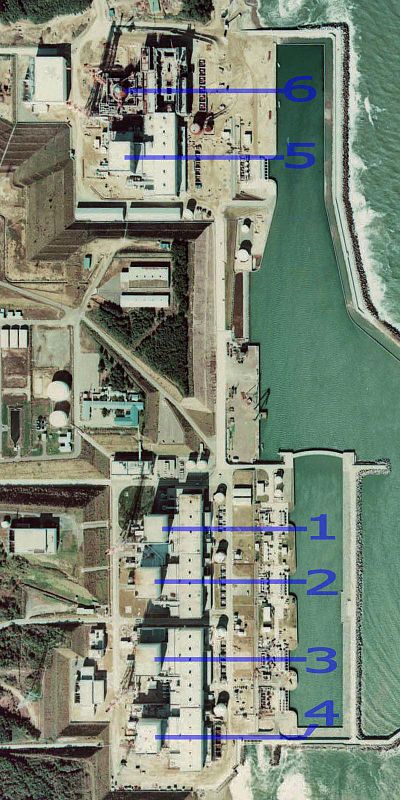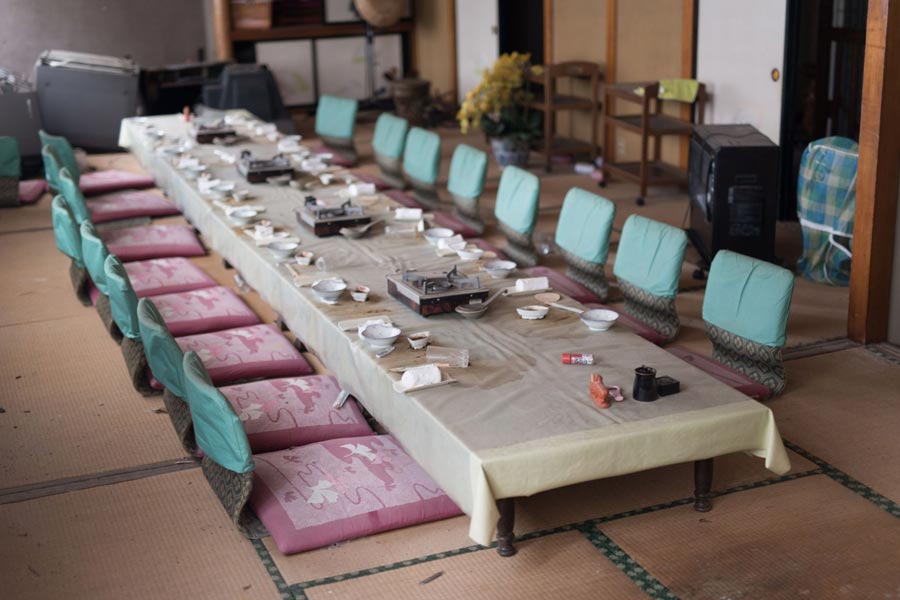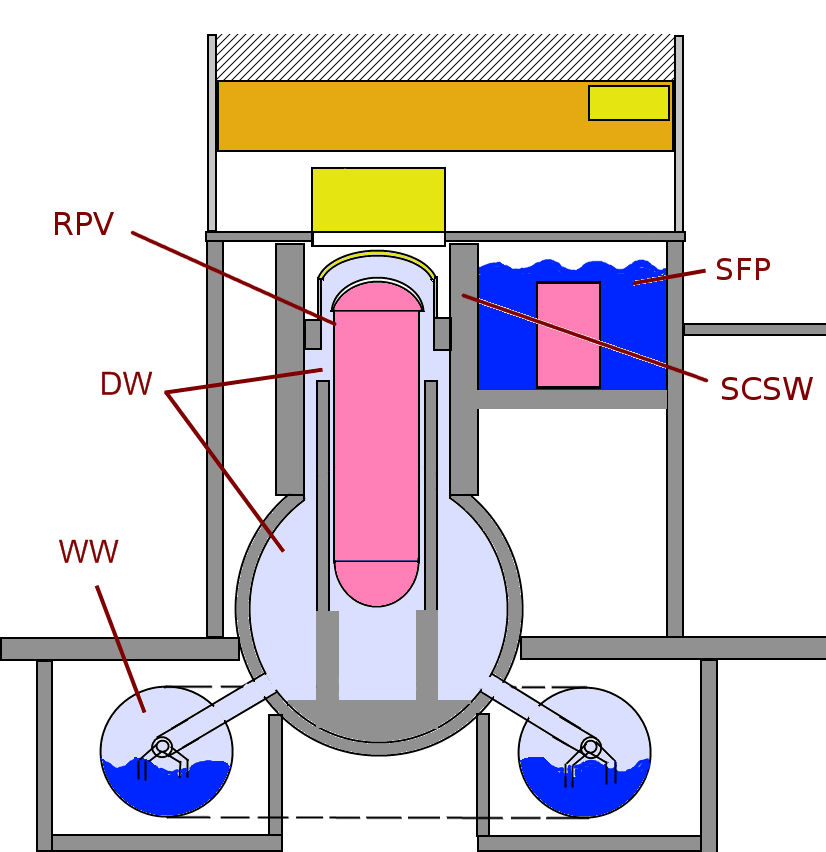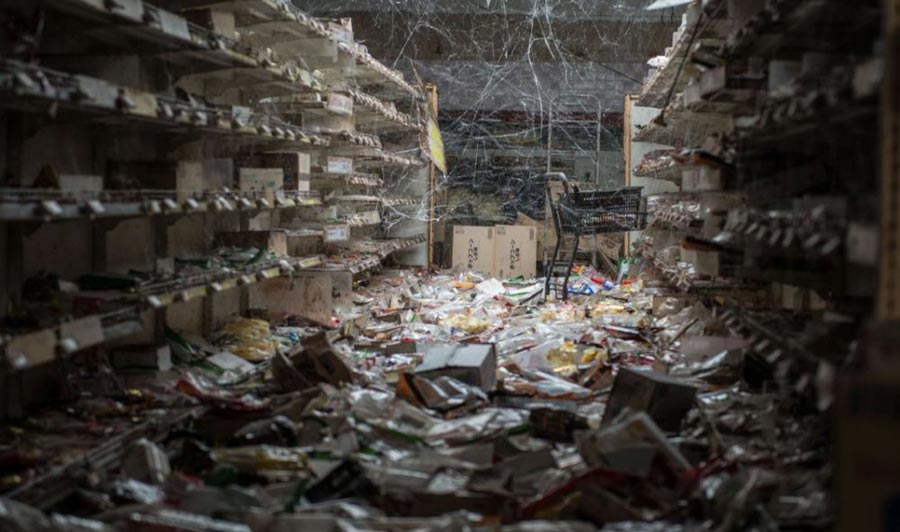The Fukushima nuclear accident refers to events that took place at the Fukushima I Nuclear Power Plant (Fukushima Daiichi) as a result of the earthquake and tsunami in the area of Sendai on March 11, 2011. Reactors 1 2 and 3 stopped automatically at the time of the earthquake, while the remaining three were already unemployed for maintenance. Tsunami (14 meters) flooded six units, located in the sea (all nuclear power plants are near a large concentration of cooling water theme), damaging the network power and emergency generators, preventing the operation of cooling systems. What happened in Fukushima on March 11 resulted in explosions, fires and emissions of radioactivity. It is considered that the events of units 1, 2 and 3 correspond to level 5 accidents (according to NISA and IAEA) on the international scale of nuclear accidents (INES). What happened in Fukushima reached the same level as the accident Harrisburg 1979.

As a result of what happened in accidents in Units 1, 2 and 3 a total of 10 workers were hospitalized, one of them have received a higher dose to 100mSv and two TEPCO workers are missing without having been confirmed their presence at the plant the day of the quake. Most of the eight hundred plant workers were being evacuated to prevent the risk of radioactive contamination and radiation, keeping the site in a group of about fifty to try to minimize the effects of the accident and put back the plant under control. To these were added later effective fire and the Japanese self-defense forces, among altres.v March 14 radioactivity had been detected 160 km away from power.
As a result of the earthquake and tsunami there were also incidents classified as level 3 on the INES scale units 1, 2 and 4 of the Fukushima nuclear power plant II (Fukushima Daini) located twelve kilometers from Fukushima I, but according to the International Atomic Energy Agency (IAEA) of the United Nations the Japanese Fukushima Daini nuclear plant, as well as those of Tokai and Onagawa, were on the 15th of March in safe and stable condition .

What happened in Fukushima?
Daily activity in the plant
The plant of Fukushima Daiichi nuclear power is a nuclear power plant that was commissioned in 1971. The plant consists of six boiling water reactors (BWR). These water reactors driving electrical generators with a combined capacity of 4.7 GW, making Fukushima Daiichi nuclear power one of the 15 largest in the world. I was the first Fukushima nuclear plant designed, built and implemented in partnership with General Electric, Boise, and Tokyo Electric Company (TEPCO).

Some elements and systems affected

Simplified boiling water reactor, BWR Mark I design with steel torus including downspouts.
Reactor pressure vessel
Wall SCSW = secondary shielding concrete
SFP spent fuel pool =
DW = Dry Well
WW = Pou dock (torus)
Waste heat and loss of reactor cooling
The nuclear reactor of the nuclear power plants after the nuclear reaction save, continue to generate heat, though less obviously when you are unemployed. In normal operation, the heat is extracted by a cooling system which circulates water but able to stop or emergency or other auxiliary systems security charge also perform this task.
If the residual heat is extracted by the failure of all systems, the temperature of the reactor core can significantly increase. This may involve, firstly, the oxidation of neighboring fuel (uranium oxide) with release of hydrogen and a possible merger of these and fuel itself if temperatures reached levels high enough. For reference, the melting point of uranium oxide is 2865 ° C. In more extreme conditions, the mixture of fuel and molten metal could penetrate the base of the reactor vessel, typically made of steel and more than twenty centimeters thick. Due to the lack of precise conditions inside some of the reactors as a result of the loss of power and the failure of some instruments caused by the earthquake, tsunami, fires or explosions, one of the priorities of the emergency teams working on the ground has been to Prevent this situation by means of providing external cooling seawater, either injected or sprayed on the reactor structure. The hypothetical situation piercing the base of the reactor could be serious because of the possibility of triggering a steam explosion, triggered by the sudden immersion in water of large amounts of molten material at very high temperatures, which could cause damage to the containment.
Spent fuel pool
The fuel pool, located outside the wall of the nuclear reactor but inside the reactor building is the pool where spent nuclear fuel is stored in order to maintain cooling once extracted from the kernel. The pool uses a cooling system separate from the reactor core to evacuate this heat, which in normal circumstances prevents the water evaporates and the fuel ends up being uncovered. Water for blocking radiation outside.
If the pool water level too low you can lose the ability to properly cool the fuel. To this we could add the release of gases and volatile elements contained within the fuel rods if the damage to the neighbors is important. The accumulation of hydrogen explosions that can cause damaging secondary containment and release of volatile radioactive isotopes in cases that secondary containment has been previously damaged, as in the case of units 1, 3 and 4 of Fukushima .
State reactors
The six reactors of the nuclear fission reactors are thermal type BWR, one of the two types most common in the world and so there is, for example, the only reactor of Cofrentes NPP. The third reactor MOX nuclear fuel work while others do very slightly enriched uranium. They were built between 1970 and 1979 by various American and Japanese companies. The time of initial operation was forty years but this period was extended in February 2011 to ten years for permission from the government.
During the earthquake, the reactors 4, 5 and 6 were unemployed for maintenance from November 30, January 3 and 14 August 2010 respectively. Reactor 4 was already empty of fuel at the time of the earthquake but not 5 and 6. Reactors 1, 2 and 3 are stopped automatically when the earthquake before the tsunami that flooded and was primarily responsible for the damage, although the intensity of the earthquake already exceeded the reference design terms accelerations in the central records of 507 compared to 449 gal design. The tsunami, however, exceeded design considerations long, 14 meters high tsunami Fukushima Daiichi before the 5.7 meter reference Design. This central still had projected the construction of two reactors, 7 and 8, in the near future.
Radiation
After the failure of cooling systems of nuclear reactors were conducted controlled emissions of radioactive gases to the outside to reduce the pressure in the containment enclosure. It was broadcast to the outside of an undetermined amount radioactive particles.
On Sunday 27 March 2011 was detected in the water inside the facilities level radiation hundred thousand times above the normal level, possibly from a leak in the reactor number 2. These levels Radiation difficult tasks of operators. Likewise, levels of radioactive iodine in the sea water in the vicinity of the plant were 1,850 times higher than that set legal limits. It is also detected plutonium outside reactor, possibly from reactor number 3, the only one that worked with this item.
A few days after the accident was detected radioactive iodine in Tokyo tap water and high levels of radioactivity in milk produced in the vicinity of the plant and spinach produced in a factory in neighboring Ibaraki Prefecture. A week after the accident were detected in California radioactive particles from Japan, who had crossed the Pacific Ocean. Some days after radioactive iodine was detected in Finland, although in both cases ruled that the radiation levels were detected dangerous.
On Wednesday 27 April 2011 was detected in Spain and in other European countries, according to the Nuclear Safety Council, an increase of iodine and cesium in the air from the Fukushima accident. The Nuclear Safety Council said there was no danger to health.
The Japanese government acknowledged that nuclear power can not again be operational and dismantle it once controlled an accident.
Effects of radioactivity
In August 2012, Japanese scientists published their results on the study of genetic mutations in butterflies of the genus Zizes exposed to radioactivity in the area near a nuclear power.
Radioactive discharges to the sea
A crack in the structure of the reactor started releasing radioactive material into the sea, making the content of radioactive iodine were some moments in nearby waters up to 7.5 million times the legal limit and that the level of Cesium was 1.1 million times above those limits. The first attempts to seal the crack with cement and other methods failed. The company TEPCO, in early April, the sea began to pour 11,500 tons of radioactively contaminated water to free up space in the Central to house the more polluted waters inside the reactors.
Damage to the people
On 17 March 2011, the total number of people directly affected by the incident at the plant was twenty and twenty wounded people affected by radioactive contamination. Two people were missing from the day of the earthquake were found dead on April 1, although his death was caused by injuries possibly caused by the tsunami, and radiation.
Friday April 1 was reported that at least 21 workers who were trying to control the reactor Fukushima plant since suffering an acceleration in the rate of DNA damage by radiation effect.
What happened in Fukushima: Event´s timeline
Images of the damage before and after the first explosion at one reactor building outside the Fukushima nuclear complex I.
Images of the damage before and after the first explosion at one reactor building outside the Fukushima nuclear complex I.
First week
11 March 2011:
The Japanese government declared a nuclear emergency caused by a failure of the cooling systems in the spent fuel pool of the nuclear reactors in Fukushima.
As a result, thousands of nearby residents to evacuate the nuclear plant.
After the experts warn of the possibility of damage to the core, the evacuation zone was extended to twenty kilometers, affecting between 110,000 200,000 people and residents of between twenty and thirty kilometers away from the plant itself ‘tells ls not go home.
22 people from the neighboring Central show signs of exposure to radioactive contamination.
The release of fission products from the damaged nuclear reactor core, especially the radioactive isotope iodine-131 and cesium-137, led the Japanese government to distribute preventive iodine (non-radioactive) to people close to the nuclear plant to be ingested as to prevent thyroid cancer.
March 12, 2011:
While growing evidence of partial melting of fuel rods in the reactor 1, an explosion destroyed the upper cladding of the building that hosts the unity of reactor 1. The explosion caused injuries to four workers, but the reactor container inside the building remains intact. It is believed that the explosion occurs as a result of a buildup of hydrogen in the building after it was ventilated steam to reduce the pressure on the wall (building side) of containment. Hydrogen is oxidized when superheated water from zirconium alloy rods that contain the reactor fuel.
Authorizing the plant operators began using sea water for emergency cooling, which surely will damage the reactor, disabling their later use.
March 13, 2011:
It begins to seem possible that there is a partial fusion reactor 3. From 13:00 JST, reactors 1 and 3 are ventilated replenished with water and boric acid to reduce temperatures and inhibit further nuclear reactions.
It is reported that the reactor 2 has a water level lower than normal but it seems stable, even though the pressure inside the containment structure (building side) is high.
The Japanese Atomic Energy Agency announced that it has classified the situation in reactors 1 and 3 at level 4 (accident with local consequences) scale International Nuclear Events (INES, International Nuclear Event Scale).
14 March 2011:
Chart the evolution of radiation in Fukushima recorded between 11 and 30 March, showing regional effects based on the weather, map and local news reports of events.
Chart the evolution of radiation in Fukushima recorded between 11 and 30 March, showing regional effects based on the weather, map and local news reports of events.
Blow up the building causing three reactor eleven wounded. No release of radioactive material beyond what is expelling the ventilation, but the explosion affects the intake of water in the reactor 2.
The chairman of the authority for nuclear safety France (ASN, Autorité de Sûreté nucléaire) said that the accident should be classified as level 5 or even 6 on the INES scale.
15 March 2011:
Problems with relief valves reactor 2 cause apparently the high pressure of the secondary containment building does not allow adding water to the point that the reactor 2 passes to occupy the more serious condition of the three reactors .
An explosion in the chamber depressurization caused some damage to the building of the reactor container.
Moreover, it is declared a fire in the spent fuel pool of reactor 4 with spent fuel rods normally kept covered with water to prevent overheating.
Radiation levels at the plant increased significantly, but then decreased again.
16 March 2011:
4 reactor, the building completely destroyed;
3 reactor, destroyed and giving off a smoke;
2 reactor, but apparently giving off smoke and Whole
1 reactor, the upper half destroyed
At 5:45 JST from Kyodo News report that a worker noticed flames on the fourth floor of the reactor 4, where the spent fuel pools. This casts doubt on hopes that the initial explosion the day before the fourth reactor building were caused by lubricating oil pumps.
TEPCO technicians report that the spent fuel rods may have been discovered and are being overheating and that “there are possibilities that the situation worse.”
At midday, television NHK TV reported that a white smoke coming from the technical account for 3 reactor.
Shortly after, reports that all workers who were at the plant, except for a very small group, were evacuated because of dangerous levels of radioactivity increase to about milisieverts thousand per hour. A press release reports that TEPCO has withdrawn all its employees at 06:00 JST caused by abnormal noises coming from one of the chambers of the reactor depressurization.
Later in the evening, Reuters reports that water is entering the reactors 5 and 6.
17 March 2011:
During the morning, military helicopters have launched four containers of water to the spent fuel pools of reactors 3 and 4.
In the afternoon reported that the pool of reactor 4 was already full of water and, therefore, none of the fuel rods were exposed to air.
They begin to realize external works to provide electricity at six reactors of Fukushima I.
From the evening, police and firemen throw water pressure from the truck to try to cool the reactor 3.
The Japanese government informed the IAEA that engineers were putting a line of external power to the reactor 2. TEPCO estimates missing fifteen hours so that we can establish the electricity, during which time continue throwing water reactor.
Second week
Computer projection of the distribution of fallout from the Fukushima nuclear accident. The area includes the distribution shown from 18 to 20 March 2011.
Computer projection of the distribution of fallout from the Fukushima nuclear accident. The area includes the distribution shown from 18 to 20 March 2011.
18 March 2011:
The Tokyo Fire Department sent thirty fire trucks with 139 men and a rescue team.
It is expected that the wind veer to the northeast and continue towards the sea, the radioactive particles away from the coast of Japan.
For the second consecutive day, high levels of radiation were detected in an area 30 km northwest of the complex.
Japanese authorities revised INES classification by the loss of cooling and damage to reactors 2 and 3, all classified at level 5, and the loss of cooling water in the reactor pool 4 as Level 3.
In a period of twenty-four hours has reduced radiation levels of 351 μSv / h 265 μSv / h, but it is unclear whether the decline was due to the efforts spraying with water.
19 March 2011:
A second group of one hundred firefighters Tokyo relieves the first team. Use a vehicle that can inject water to a height of 22 meters to cool the spent fuel pool inside the reactor 3. The water pressure was released to the reactor for seven hours. The TEPCO reported later that the water seemed to have been effective in reducing the temperature around the fuel rods used to less than 100 ° C (boiling point).
20 March 2011:
Achieved reconnect electricity to reactor 2 but work continues to ensure that the devices are operating.
Diesel engines 6 reactor began supplying power to restart the cooling of reactors 5 and 6 that back in cold shutdown and cooling of the fuel pools are back in their normal operating temperatures.
The TEPCO announced that the reactor pressure vessel 3 was increasing, it might be necessary ventilation, expelling steam with radioactive particles to release their pressure, though, later, TEPCO has not in operation it is considered necessary.
Although it adds to a generally positive evaluation of progress towards total control from the Japanese government “confirm first that the nuclear complex, which suffered significant damage to the reactors and buildings, and has produced the radioactive contamination around , will be closed once the crisis ends. “
It confirms the increase of radioactivity in the soil in the vicinity of the plant. 20 km from the nuclear measured amounts of radioactive iodine-131 in milk exceeding 1.000Bq / kg, ten times the maximum allowed by international rules, which makes it inappropriate to drink. Also measured amounts “alarming” in the words of the French Nuclear Safety Authority, spinach cesium-137, at distances of up to one hundred and sixty kilometers from the plant.
21 March 2011:
The repair works are underway interrupted by the appearance of a column of gray smoke in December by the southeast side of the reactor 3 (towards the swimming pool of spent fuel) for two hours. Workers in this reactor are evacuated, even though there are no changes in measurements of radioactivity or the state of the reactor. During this time it continues to work (such as restoring electricity) could have influenced the fire.
You can also see white smoke, probably steam from the reactor 2, and if this is accompanied by an increase in radiation levels.
It extends a new power line to reactor 4 reactor 5 and he returns their own energy from the external transmission line instead of sharing generators reactor 6.
22 March 2011:
Although smoke out of the reactors 2 and 3, but is less visible and is stifling steam after operations to spray water in buildings.
Continue repair work after having been unemployed for concern about the smoke, but no changes in radiation levels to restore electricity. The power cord is connected to the reactor 4
Continue injecting sea water reactors 1 to 3.
It is reported that wires were connected to external current six reactors. Light returns to the control room of reactor 3.
March 23, 2011:
At dusk, smoke back out of the reactor 3, this time in black and gray, causing a new evacuation of workers around the area. A video showing air plant that looks like a small fire at the base of the columns of smoke inside the reactor building heavily damaged. The TEPCO said they were not aware of the source of fire and smoke.
Restored the water supply systems of the reactor 1 enabling increased water added to the reactor.
The Japanese government warns that high levels of radioactivity have been detected (about twice the legal limit for children) to Tokyo to see the water and therefore can not be used for feeding babies .
24 March 2011:
The injection of seawater at reactors 1, 2 and 3 continues.
Radiation levels near the complex reduced to 200 μSv / h.
Correunt resets the electrical control room of reactor 1, even the lighting of the room.
Three workers exposed to high levels of radiation (two of them need hospitaització) after radioactive water leak through the protective suits. They were exposed to a dose equivalent to 2SV -6Sv skin. Not wearing protective boots, although safety manuals state that the company “does not assume a scenario in which their employees do work rights in water in a nuclear plant.” The amount of radioactivity in the water was 3.9 MBq / mL, and would be contaminated by nucleotides of damaged fuel rods, which would indicate a crack in the core.
The temperature of the outer surface of reactors 1, 2, 3 and 4 continue to decline to be below 20 ° C.
Third week
25 March 2011:
NISA announced the possibility that there is a crack in the containment vessel of reactor 3, though the radioactive water in the basement there could come from fuel storage pool.
Also highly radioactive water found in turbine buildings of reactors 1 and 2.
The US Navy sent a ship with 1,890 cubic meters (500,000 US gallons) of fresh water, which is expected to arrive in two days.
Japan announced that it will offer transport in a voluntary evacuation zone of 30 km (19 miles).
Japanese authorities report that drinking water is again safe for children in Tokyo and Chiba, though still exceeding the limits in Tokaimura and Hitachi.
Iodine-131 as the ocean around 50 Bq / ml, a “relatively high” 1,250 times normal.
Management of natural hazards post-accident
Management of the plant before the earthquake and tsunami
On 12 October 2012, Japanese power company TEPCO, which operates the Fukushima Daiichi plant, admitted for the first time that had minimized the risk of tsunami for fear of closure to improve security.
Management after the accident
Special Law 156 of 17 December 1999 (Act special nuclear emergency preparedness) and Act 156 of 17 December 1999 (Nuclear Emergency Preparedness) are the two main bases that replaced Law 223 1961 (Act of disaster control measures). The operator of this, way, must have prepared a contingency plan under Article 7 of the law. Also, it aims to have approval authority for all actions not included in the plan.
Evacuation
The evidence suggests that, at the outset of the disaster, the plant operator would have considered the evacuation of all workers of the place; information that the president of TEPCO, Masataka Shimizu M. complaint, alleging a misunderstanding.
Consequences of the accident
The conclusions are based on 144 samples of adult butterflies Japan. The results claim that 12% of the specimens exposed to fallout immediately after the accident, show abnormalities. 18% of the descendants of these also have defects, a percentage that rises to 34% in the third generation.

Radiation from Fukushima has manifested in offspring of butterflies that live in Japan, which have smaller wings and damaged eyes.
The emissions and radioactive discharges several kilometers from the Fukushima plant make it impossible in this area of human life.
Radioactive substances that were spilled into the environment -water, land, air with spread will continue in the future, creating new risks to the health of plants, animals and humans.
Radionuclides iodine and cesium emitted by the damaged reactors were transported across the Pacific Ocean, crossed North America and then came to Europe across the Atlantic Ocean; therefore, has increased the level of radioactivity in these oceans.
A moderate exposure to radiation can cause long-term continuous problem of cancer induction, but usually in very low percentages of the population.
Radioactivity can be transmitted through the food chain, as the ingestion of a plant or animal that has received a dose of radiation causes the transmission of radioactive particles in the body ingestor. That´s one of the reasons why what happened in Fukushima was son dangerous for the people who lived there.

